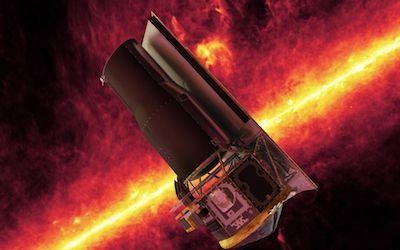Tue, Nov 07, 2017
Posts Request For Information From Commercial Companies Interested In Operating The Spacecraft
NASA's Science Mission Directorate (SMD) is seeking information from parties who are interested in operating the Spitzer Space Telescope using non-NASA funding, including defining and executing a Spitzer science program, beyond the timeframe of the NASA-funded mission.

According to a Request for Information (RFI) posted to the GSA website, the Astrophysics Division of SMD has committed support for Spitzer operations through March 2019. If no engineering impediments arise, the agency estimates that current Spitzer operations could continue through September 2019 and operations beyond September 2020 should be possible for the lowest data volume observing modes. The FY18 cost of Spitzer operations, without direct science data analysis funding for the Guest Observer (GO) program and Deep Space Network (DSN) support, is $14 million. Responses to this Request for Information are sought from all interested domestic parties.
The Spitzer Space Telescope was launched in 2003 as NASA's Great Observatory for infrared exploration of the Universe, and the prime mission was completed in mid-2009 after the exhaustion of the on-board cryogen. Since that time the observatory has operated with the two shortest wavelength arrays of the Infrared Array Camera (IRAC) at 3.6 and 4.5 µm. IRAC performance continues to be excellent. As Spitzer progresses along its Earth trailing orbit the geometry between the observatory, the Sun, and the Earth changes in such a way that in order to point the body-fixed high-gain antenna for communications, the observatory has to orient to greater solar pitch angles. Ensuring safe and efficient operations under these conditions poses the main challenge to prolonged operations.
While the upcoming James Webb Space Telescope's capabilities will exceed Spitzer's for most observing programs, Spitzer's demonstrated relative photometry precision, mapping speed and ability to make very long observations, interrupted only by downlinks every 24-48 hours, still provide unique capabilities for studies of exoplanets, extragalactic surveys and other science programs that benefit from its unique attributes.
However, the agency points out that an RFI is NOT a Request for Proposal, nor Invitation for Bid. This RFI is being used to obtain information for planning purposes only, and the Government does not intend to award a contract at this time.
(Source: GSA website. Image from file)
More News
19-Year-Old Pilot Was Attempting to Fly Solo to All Seven Continents On his journey to become the first pilot to land solo on all seven continents, 19-year-old Ethan Guo has hit a >[...]
From 2017 (YouTube Edition): A Quality LSA For Well Under $100k… Aeroprakt unveiled its new LSA at the Deland Sport Aviation Showcase in November. Dennis Long, U.S. Importer>[...]
Hazardous Weather Information Summary of significant meteorological information (SIGMET/WS), convective significant meteorological information (convective SIGMET/WST), urgent pilot>[...]
Aero Linx: Historic Aircraft Association (HAA) The Historic Aircraft Association (HAA) was founded in 1979 with the aim of furthering the safe flying of historic aircraft in the UK>[...]
"We would like to remember Liam not just for the way he left this world, but for how he lived in it... Liam was fearless, not necessarily because he wasn't afraid but because he re>[...]
 TikToker Arrested After Landing His C182 in Antarctica
TikToker Arrested After Landing His C182 in Antarctica Classic Aero-TV: Versatile AND Practical - The All-Seeing Aeroprakt A-22 LSA
Classic Aero-TV: Versatile AND Practical - The All-Seeing Aeroprakt A-22 LSA ANN's Daily Aero-Term (06.27.25): Hazardous Weather Information
ANN's Daily Aero-Term (06.27.25): Hazardous Weather Information ANN's Daily Aero-Linx (06.27.25)
ANN's Daily Aero-Linx (06.27.25) Aero-News: Quote of the Day (06.27.25)
Aero-News: Quote of the Day (06.27.25)



